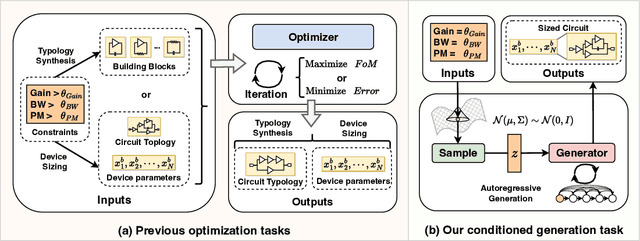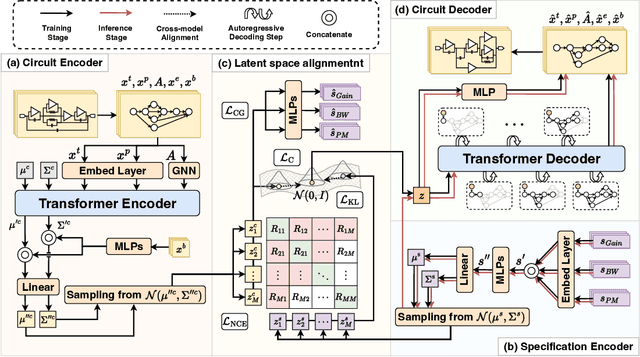Hehe Fan
VideoGrain: Modulating Space-Time Attention for Multi-grained Video Editing
Feb 24, 2025Abstract:Recent advancements in diffusion models have significantly improved video generation and editing capabilities. However, multi-grained video editing, which encompasses class-level, instance-level, and part-level modifications, remains a formidable challenge. The major difficulties in multi-grained editing include semantic misalignment of text-to-region control and feature coupling within the diffusion model. To address these difficulties, we present VideoGrain, a zero-shot approach that modulates space-time (cross- and self-) attention mechanisms to achieve fine-grained control over video content. We enhance text-to-region control by amplifying each local prompt's attention to its corresponding spatial-disentangled region while minimizing interactions with irrelevant areas in cross-attention. Additionally, we improve feature separation by increasing intra-region awareness and reducing inter-region interference in self-attention. Extensive experiments demonstrate our method achieves state-of-the-art performance in real-world scenarios. Our code, data, and demos are available at https://knightyxp.github.io/VideoGrain_project_page/
DreamDPO: Aligning Text-to-3D Generation with Human Preferences via Direct Preference Optimization
Feb 05, 2025Abstract:Text-to-3D generation automates 3D content creation from textual descriptions, which offers transformative potential across various fields. However, existing methods often struggle to align generated content with human preferences, limiting their applicability and flexibility. To address these limitations, in this paper, we propose DreamDPO, an optimization-based framework that integrates human preferences into the 3D generation process, through direct preference optimization. Practically, DreamDPO first constructs pairwise examples, then compare their alignment with human preferences using reward or large multimodal models, and lastly optimizes the 3D representation with a preference-driven loss function. By leveraging pairwise comparison to reflect preferences, DreamDPO reduces reliance on precise pointwise quality evaluations while enabling fine-grained controllability through preference-guided optimization. Experiments demonstrate that DreamDPO achieves competitive results, and provides higher-quality and more controllable 3D content compared to existing methods. The code and models will be open-sourced.
BVINet: Unlocking Blind Video Inpainting with Zero Annotations
Feb 03, 2025



Abstract:Video inpainting aims to fill in corrupted regions of the video with plausible contents. Existing methods generally assume that the locations of corrupted regions are known, focusing primarily on the "how to inpaint". This reliance necessitates manual annotation of the corrupted regions using binary masks to indicate "whereto inpaint". However, the annotation of these masks is labor-intensive and expensive, limiting the practicality of current methods. In this paper, we expect to relax this assumption by defining a new blind video inpainting setting, enabling the networks to learn the mapping from corrupted video to inpainted result directly, eliminating the need of corrupted region annotations. Specifically, we propose an end-to-end blind video inpainting network (BVINet) to address both "where to inpaint" and "how to inpaint" simultaneously. On the one hand, BVINet can predict the masks of corrupted regions by detecting semantic-discontinuous regions of the frame and utilizing temporal consistency prior of the video. On the other hand, the predicted masks are incorporated into the BVINet, allowing it to capture valid context information from uncorrupted regions to fill in corrupted ones. Besides, we introduce a consistency loss to regularize the training parameters of BVINet. In this way, mask prediction and video completion mutually constrain each other, thereby maximizing the overall performance of the trained model. Furthermore, we customize a dataset consisting of synthetic corrupted videos, real-world corrupted videos, and their corresponding completed videos. This dataset serves as a valuable resource for advancing blind video inpainting research. Extensive experimental results demonstrate the effectiveness and superiority of our method.
TV-Dialogue: Crafting Theme-Aware Video Dialogues with Immersive Interaction
Jan 31, 2025Abstract:Recent advancements in LLMs have accelerated the development of dialogue generation across text and images, yet video-based dialogue generation remains underexplored and presents unique challenges. In this paper, we introduce Theme-aware Video Dialogue Crafting (TVDC), a novel task aimed at generating new dialogues that align with video content and adhere to user-specified themes. We propose TV-Dialogue, a novel multi-modal agent framework that ensures both theme alignment (i.e., the dialogue revolves around the theme) and visual consistency (i.e., the dialogue matches the emotions and behaviors of characters in the video) by enabling real-time immersive interactions among video characters, thereby accurately understanding the video content and generating new dialogue that aligns with the given themes. To assess the generated dialogues, we present a multi-granularity evaluation benchmark with high accuracy, interpretability and reliability, demonstrating the effectiveness of TV-Dialogue on self-collected dataset over directly using existing LLMs. Extensive experiments reveal that TV-Dialogue can generate dialogues for videos of any length and any theme in a zero-shot manner without training. Our findings underscore the potential of TV-Dialogue for various applications, such as video re-creation, film dubbing and its use in downstream multimodal tasks.
Prompt-Aware Controllable Shadow Removal
Jan 25, 2025



Abstract:Shadow removal aims to restore the image content in shadowed regions. While deep learning-based methods have shown promising results, they still face key challenges: 1) uncontrolled removal of all shadows, or 2) controllable removal but heavily relies on precise shadow region masks.To address these issues, we introduce a novel paradigm: prompt-aware controllable shadow removal. Unlike existing approaches, our paradigm allows for targeted shadow removal from specific subjects based on user prompts (e.g., dots, lines, or subject masks). This approach eliminates the need for shadow annotations and offers flexible, user-controlled shadow removal.Specifically, we propose an end-to-end learnable model, the \emph{\textbf{P}}rompt-\emph{\textbf{A}}ware \emph{\textbf{C}}ntrollable \emph{\textbf{S}}hadow \emph{\textbf{R}}emoval \emph{\textbf{Net}}work (PACSRNet). PACSRNet consists of two key modules: a prompt-aware module that generates shadow masks for the specified subject based on the user prompt, and a shadow removal module that uses the shadow prior from the first module to restore the content in the shadowed regions.Additionally, we enhance the shadow removal module by incorporating feature information from the prompt-aware module through a linear operation, providing prompt-guided support for shadow removal.Recognizing that existing shadow removal datasets lack diverse user prompts, we contribute a new dataset specifically designed for prompt-based controllable shadow removal.Extensive experimental results demonstrate the effectiveness and superiority of PACSRNet.
Prototypical Calibrating Ambiguous Samples for Micro-Action Recognition
Dec 19, 2024



Abstract:Micro-Action Recognition (MAR) has gained increasing attention due to its crucial role as a form of non-verbal communication in social interactions, with promising potential for applications in human communication and emotion analysis. However, current approaches often overlook the inherent ambiguity in micro-actions, which arises from the wide category range and subtle visual differences between categories. This oversight hampers the accuracy of micro-action recognition. In this paper, we propose a novel Prototypical Calibrating Ambiguous Network (\textbf{PCAN}) to unleash and mitigate the ambiguity of MAR. \textbf{Firstly}, we employ a hierarchical action-tree to identify the ambiguous sample, categorizing them into distinct sets of ambiguous samples of false negatives and false positives, considering both body- and action-level categories. \textbf{Secondly}, we implement an ambiguous contrastive refinement module to calibrate these ambiguous samples by regulating the distance between ambiguous samples and their corresponding prototypes. This calibration process aims to pull false negative ($\mathbb{FN}$) samples closer to their respective prototypes and push false positive ($\mathbb{FP}$) samples apart from their affiliated prototypes. In addition, we propose a new prototypical diversity amplification loss to strengthen the model's capacity by amplifying the differences between different prototypes. \textbf{Finally}, we propose a prototype-guided rectification to rectify prediction by incorporating the representability of prototypes. Extensive experiments conducted on the benchmark dataset demonstrate the superior performance of our method compared to existing approaches. The code is available at https://github.com/kunli-cs/PCAN.
EnergyMoGen: Compositional Human Motion Generation with Energy-Based Diffusion Model in Latent Space
Dec 19, 2024Abstract:Diffusion models, particularly latent diffusion models, have demonstrated remarkable success in text-driven human motion generation. However, it remains challenging for latent diffusion models to effectively compose multiple semantic concepts into a single, coherent motion sequence. To address this issue, we propose EnergyMoGen, which includes two spectrums of Energy-Based Models: (1) We interpret the diffusion model as a latent-aware energy-based model that generates motions by composing a set of diffusion models in latent space; (2) We introduce a semantic-aware energy model based on cross-attention, which enables semantic composition and adaptive gradient descent for text embeddings. To overcome the challenges of semantic inconsistency and motion distortion across these two spectrums, we introduce Synergistic Energy Fusion. This design allows the motion latent diffusion model to synthesize high-quality, complex motions by combining multiple energy terms corresponding to textual descriptions. Experiments show that our approach outperforms existing state-of-the-art models on various motion generation tasks, including text-to-motion generation, compositional motion generation, and multi-concept motion generation. Additionally, we demonstrate that our method can be used to extend motion datasets and improve the text-to-motion task.
InfiniDreamer: Arbitrarily Long Human Motion Generation via Segment Score Distillation
Nov 27, 2024



Abstract:We present InfiniDreamer, a novel framework for arbitrarily long human motion generation. InfiniDreamer addresses the limitations of current motion generation methods, which are typically restricted to short sequences due to the lack of long motion training data. To achieve this, we first generate sub-motions corresponding to each textual description and then assemble them into a coarse, extended sequence using randomly initialized transition segments. We then introduce an optimization-based method called Segment Score Distillation (SSD) to refine the entire long motion sequence. SSD is designed to utilize an existing motion prior, which is trained only on short clips, in a training-free manner. Specifically, SSD iteratively refines overlapping short segments sampled from the coarsely extended long motion sequence, progressively aligning them with the pre-trained motion diffusion prior. This process ensures local coherence within each segment, while the refined transitions between segments maintain global consistency across the entire sequence. Extensive qualitative and quantitative experiments validate the superiority of our framework, showcasing its ability to generate coherent, contextually aware motion sequences of arbitrary length.
CktGen: Specification-Conditioned Analog Circuit Generation
Oct 01, 2024



Abstract:Automatic synthesis of analog circuits presents significant challenges. Existing methods usually treat the task as optimization problems, which limits their transferability and reusability for new requirements. To address this limitation, we introduce a task that directly generates analog circuits based on specified specifications, termed specification-conditioned analog circuit generation. Specifically, we propose CktGen, a simple yet effective variational autoencoder (VAE) model, that maps specifications and circuits into a joint latent space, and reconstructs the circuit from the latent. Moreover, given that a single specification can correspond to multiple distinct circuits, simply minimizing the distance between the mapped latent representations of the circuit and specification does not capture these one-to-many relationships. To address this, we integrate contrastive learning and classifier guidance to prevent model collapse. We conduct comprehensive experiments on the Open Circuit Benchmark (OCB) and introduce new evaluation metrics for cross-model consistency in the specification-to-circuit generation task. Experimental results demonstrate substantial improvements over existing state-of-the-art methods.
ZeroMamba: Exploring Visual State Space Model for Zero-Shot Learning
Aug 27, 2024Abstract:Zero-shot learning (ZSL) aims to recognize unseen classes by transferring semantic knowledge from seen classes to unseen ones, guided by semantic information. To this end, existing works have demonstrated remarkable performance by utilizing global visual features from Convolutional Neural Networks (CNNs) or Vision Transformers (ViTs) for visual-semantic interactions. Due to the limited receptive fields of CNNs and the quadratic complexity of ViTs, however, these visual backbones achieve suboptimal visual-semantic interactions. In this paper, motivated by the visual state space model (i.e., Vision Mamba), which is capable of capturing long-range dependencies and modeling complex visual dynamics, we propose a parameter-efficient ZSL framework called ZeroMamba to advance ZSL. Our ZeroMamba comprises three key components: Semantic-aware Local Projection (SLP), Global Representation Learning (GRL), and Semantic Fusion (SeF). Specifically, SLP integrates semantic embeddings to map visual features to local semantic-related representations, while GRL encourages the model to learn global semantic representations. SeF combines these two semantic representations to enhance the discriminability of semantic features. We incorporate these designs into Vision Mamba, forming an end-to-end ZSL framework. As a result, the learned semantic representations are better suited for classification. Through extensive experiments on four prominent ZSL benchmarks, ZeroMamba demonstrates superior performance, significantly outperforming the state-of-the-art (i.e., CNN-based and ViT-based) methods under both conventional ZSL (CZSL) and generalized ZSL (GZSL) settings. Code is available at: https://anonymous.4open.science/r/ZeroMamba.
 Add to Chrome
Add to Chrome Add to Firefox
Add to Firefox Add to Edge
Add to Edge